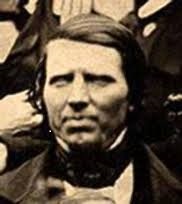
Did you know Emma had one covert, due to her influence eventually led to the conversion of thousands?
Dan and Jane Jones immigrated to the United States, and by 1841 they were residents of St. Louis, Missouri. On May 10 of that year, Dan Jones, as an American citizen, applied for a license to ply the Ripple, a thirty-eight-ton steamer, on the Mississippi River. Jones was part owner and captain of the vessel, one of the smallest registered on the upper Mississippi. Six months later, when the Ripple struck a rock and sank near Galena, Illinois, Dan immediately began work on the construction of another steamer, the Maid of Iowa. (See Donald L. Enders, BYU Studies, Spring 1979, pp. 321–35.) In partnership with Levi Moffit, an Augusta, Iowa, businessman, Jones began plying the Mississippi with this sixty-ton vessel in October of 1842.
It was about this time that Captain Jones began to notice the negative comm ents of Thomas Sharp in the Warsaw Signal about an obscure people called Mormons. In his 1847 Hanes Saint y Dyddiau Diweddaf (or History of the Latter-day Saints, Merthyr Tydfil: J. Jones, 1847), he recalled his reaction: “Through a careful investigation of the accusations I perceived clearly that it was impossible for them to be true, either because in their zeal they overstated the case or because they contradicted themselves in some way.” (P. 59; all Welsh-to-English translations are the author’s.)
ents of Thomas Sharp in the Warsaw Signal about an obscure people called Mormons. In his 1847 Hanes Saint y Dyddiau Diweddaf (or History of the Latter-day Saints, Merthyr Tydfil: J. Jones, 1847), he recalled his reaction: “Through a careful investigation of the accusations I perceived clearly that it was impossible for them to be true, either because in their zeal they overstated the case or because they contradicted themselves in some way.” (P. 59; all Welsh-to-English translations are the author’s.)
He then explained how the words of Emma Smith prompted him to sympathize with LDS beliefs: “Soon, purely by accident, there fell into my hands a segment of a letter which the wife of Joseph Smith had written to some religious sister when she was [visiting] her husband in the Missouri prison; and I shall never forget the feelings which that segment of a letter caused me to have. I perceived clearly that not only did its author believe the New Testament, the same as I—professing the apostolic faith, and rejoicing in the midst of her tribulations at being worthy to suffer all that for a testimony of Jesus and the gospel—but also it contained better counsel, more wisdom, and showed a more gospel-like and godly spirit than anything I had ever read!” (P. 60.)
The impact of the letter was such that Dan Jones was not satisfied until he was able to talk with someone about The Church of Jesus Christ of Latter-day Saints. Several late-night conversations convinced him that he was nearly a full-fledged Latter-day Saint already. Reluctant to sacrifice his popularity and livelihood as a steamboat captain, he searched for counterarguments to this new religion in order to pacify his conscience for not converting to the newfound faith. “But I shall be forever grateful,” he later wrote, “that the task was too difficult and endless for me.” (Hanes Saint y Dyddiau Diweddaf, p. 60.)
On 19 January 1843, Dan Jones was baptized in the icy waters of the Mississippi.
